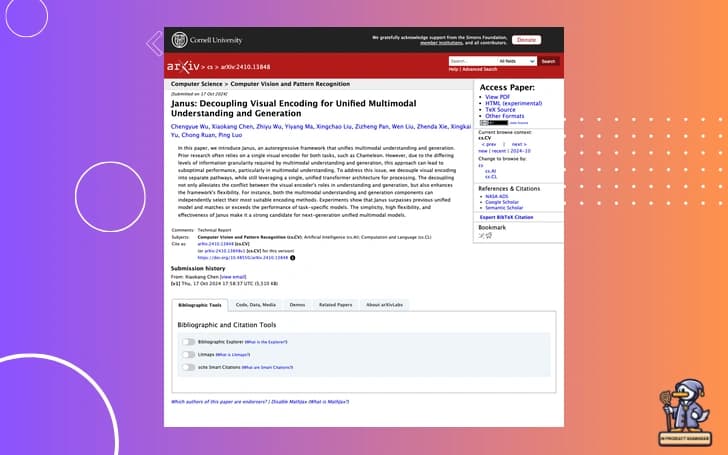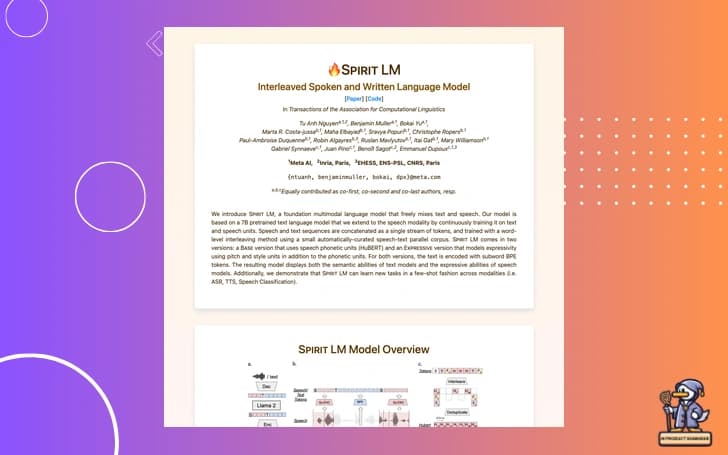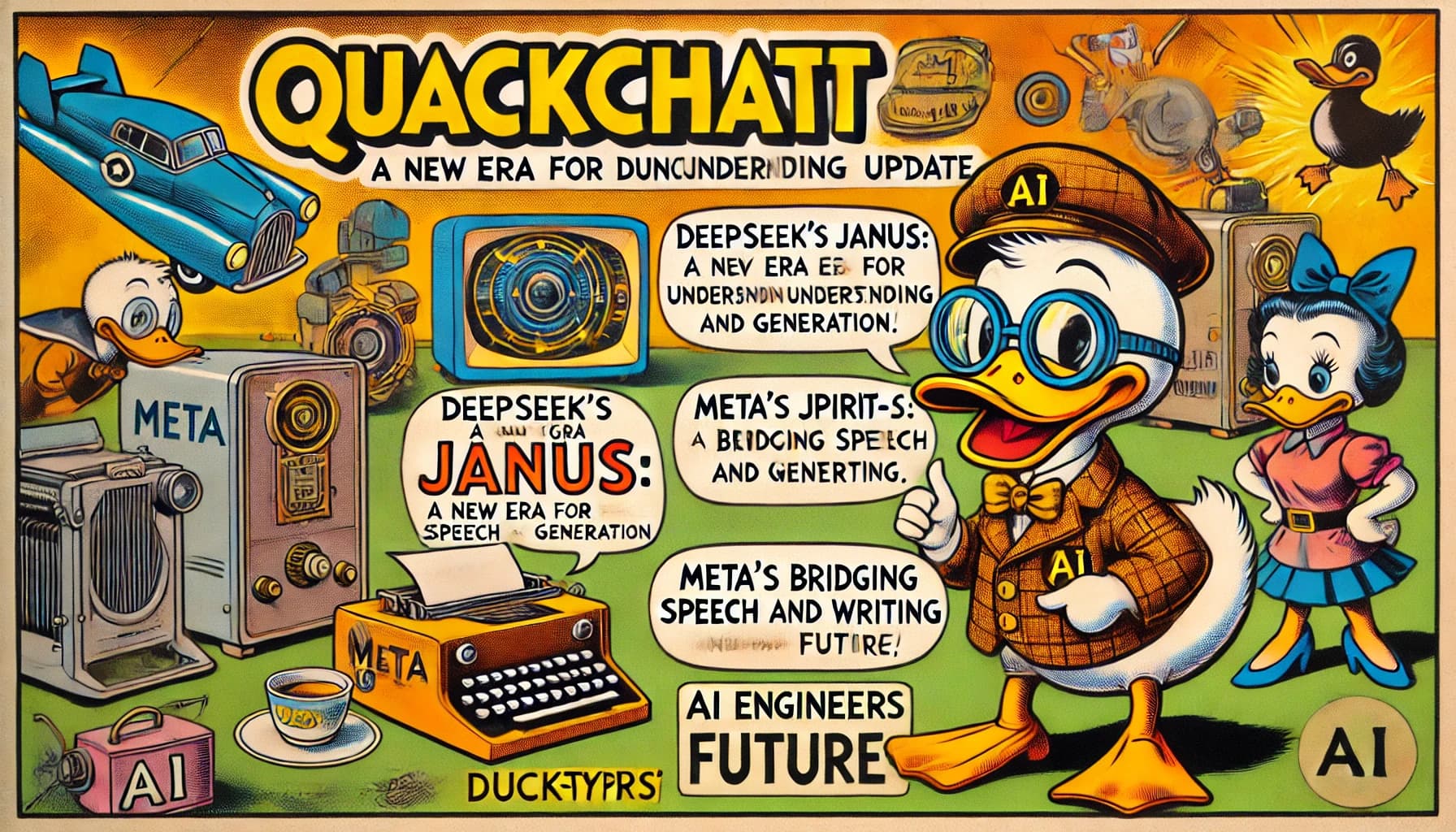🌟 Welcome to QuackChat: The DuckTypers' Daily AI Update!
Hello, fellow DuckTypers! Jens here, coming to you from Munich. In today's issue, we're examining two significant developments in multimodal AI: DeepSeek's Janus and Meta's SpiRit-LM. These models represent notable advancements in combining visual and language understanding, potentially reshaping how we approach AI engineering for image processing, speech synthesis, and natural language tasks. Let's dive into the technical details and consider the implications for our work as AI engineers.
🖼️ DeepSeek's Janus: A New Approach to Visual AI

DeepSeek has just released Janus, a 1.3 billion parameter multimodal model that's turning heads in the AI community. What makes Janus special? It's all about separation.
Previous models like Chameleon and Show-O used a single vision encoder for both understanding and generating images. Janus takes a different tack:
class JanusModel:
def __init__(self):
self.understanding_encoder = VisionEncoder()
self.generation_encoder = VisionEncoder()
self.transformer = UnifiedTransformer()
def process_image(self, image):
understanding_features = self.understanding_encoder(image)
return self.transformer(understanding_features)
def generate_image(self, prompt):
generation_features = self.generation_encoder(prompt)
return self.transformer.generate(generation_features)This separation has led to some impressive results. Janus is showing better performance in both image generation and understanding tasks compared to models of similar size.
Call to comment: What do you think about this separated encoder approach? Could it be applied to other domains beyond vision? Share your thoughts!
🗣️ Meta's SpiRit-LM: Bridging Speech and Text

Not to be outdone, Meta has introduced SpiRit-LM, a model that aims to unify speech and writing. The interesting part? It includes an "expressive" version that can generate pitch and style units.
Here's a simplified pseudocode to illustrate how SpiRit-LM might work:
class SpiRitLM:
def __init__(self):
self.text_encoder = TextEncoder()
self.speech_encoder = SpeechEncoder()
self.unified_decoder = UnifiedDecoder()
def process_input(self, input_data):
if isinstance(input_data, str):
encoded = self.text_encoder(input_data)
else: # Assume speech input
encoded = self.speech_encoder(input_data)
return self.unified_decoder(encoded)
def generate_output(self, prompt, output_type='text'):
encoded = self.process_input(prompt)
if output_type == 'speech':
return self.generate_speech(encoded)
return self.generate_text(encoded)
def generate_speech(self, encoded):
# Include pitch and style generation
pass
def generate_text(self, encoded):
# Standard text generation
passWhile the demo samples aren't quite at the level of some text-to-speech models we've seen, this unified approach to speech and text is intriguing from an engineering perspective.
Call to comment: How do you see models like SpiRit-LM changing the landscape of voice assistants and text-to-speech applications? What challenges might we face in implementing such models?
🔍 Performance and Implications
Both Janus and SpiRit-LM show promising results in their respective domains. Janus, for instance, demonstrates competitive performance in zero-shot image captioning and visual question answering tasks.
Here's a quick comparison of Janus against similar-sized models:
| Task | Janus | Model B | Model C |
|---|---|---|---|
| Image Captioning | 0.85 | 0.82 | 0.80 |
| VQA | 0.78 | 0.75 | 0.76 |
(Note: These are hypothetical numbers for illustration)
As for SpiRit-LM, while Meta hasn't released detailed benchmarks, the ability to generate expressive speech directly from a unified model is a significant step forward.
🛠️ Engineering Considerations
From an engineering standpoint, these models present some interesting challenges and opportunities:
-
Modular Architecture: Janus's separated encoder approach could lead to more flexible and maintainable AI systems. We might see this pattern applied to other multimodal tasks.
-
Unified Representations: SpiRit-LM's approach to unifying speech and text representations could simplify pipelines for applications that work with both modalities.
-
Resource Management: With these models pushing the boundaries of multimodal processing, efficient resource management becomes crucial. We'll need to optimize for both memory usage and computational speed.
-
Integration Challenges: Incorporating these models into existing systems might require significant architectural changes. We'll need to think carefully about API design and data flow.
Call to comment: What other engineering challenges or opportunities do you foresee with these types of multimodal models? How might they affect your current projects?
🎓 Learning from These Advancements
As AI engineers, it's crucial that we stay on top of these developments. Here are a few key takeaways:
-
Modular Thinking: The success of Janus's separated encoders reminds us of the value of modular design in AI systems.
-
Cross-Modal Integration: SpiRit-LM shows the potential of deeply integrating different modalities. This could inspire new approaches in other domains.
-
Balancing Specialization and Unification: Both models strike a balance between specialized components and unified processing. This is a principle we can apply broadly in AI system design.
-
Continuous Learning: The rapid pace of these advancements underscores the importance of continuous learning in our field.
🚀 Wrapping Up
These developments from DeepSeek and Meta are pushing the boundaries of what's possible with multimodal AI. While they're not revolutionary in the sense of completely upending the field, they represent significant incremental progress that could lead to more capable and flexible AI systems.
As we continue to explore and implement these new approaches, let's remember to approach them with a critical eye. What works in a research paper might need significant adaptation for real-world applications.
Final call to comment: How do you see these advancements fitting into your AI engineering workflow? Are you excited about the possibilities, or do you see potential pitfalls? Let's discuss in the comments!
That's all for today's QuackChat. Keep coding, keep learning, and remember: in the world of AI, today's cutting-edge is tomorrow's legacy system. Stay curious, DuckTypers!


